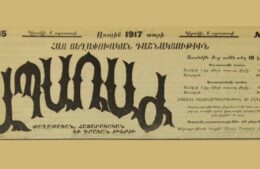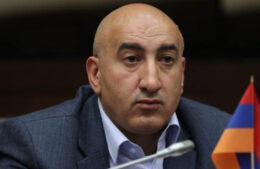Kidnapped Three years Ago In Syria, Armenian Priest Is Still Missing
- (0)
Kidnapped Three years Ago In Syria, Armenian Priest Is Still Missing –

Armenian Catholic Priest Fr. Michel Kayal and Greek Orthodox priest Fr. Maher Mahfouz Were Kidnapped on February 9, 2013. Six clergy have vanished without a trace since the Syrian conflict erupted.
By Ed West
Tha Catholic Herald – Syria may be the most dangerous place in the world to be a priest today.
Priests cannot remain underground: many have to serve several villages and risk their lives making the hazardous journey between them. They never know if the Islamists who are determined to drive Christians out of the country lie in wait for them. It’s true that priests are far from the only ones in danger in Syria. Some 250,000 people have died in a civil war that has widened into a proxy regional conflict.
An estimated 2,600 people have gone missing. Armed groups are known to have kidnapped another 1,200. Many of the nation’s ancient cities lie in ruins. And much of the land where the name “Christian” was first used is in the hands of black-clad warriors dedicated to establishing an Islamic state on seventh-century lines.
Nevertheless, the Syrian conflict has created a significant number of clerical casualties. In October 2012, for example, Fr Fadi Haddad, a Greek Orthodox parish priest in Qatana, 12 miles south-west of Damascus, was kidnapped. His badly disfigured body was discovered later on the roadside.
In June 2013, 49-year-old Fr François Murad was killed by a gunshot inside his church in the Christian village of al-Ghassanieh, in north-west Syria. Before the true cause of his death was discovered, a video purportedly showing jihadists beheading Fr Murad was shared on the internet and even covered by the mainstream media. It turned out to be fake.
Perhaps the most famous slain cleric is Fr Frans van der Lugt, a Dutch Jesuit who lived in Syria for 40 years. He spent the last three years of his life in the besieged Old City of Homs, suffering severe privations alongside the mainly Muslim population.
Fr van der Lugt led many Christians to safety at the Lebanese border. But when he was given the chance to escape himself he chose to remain in Homs, where he was shot dead on April 7, 2014.
In some ways, the kidnapped priests are the lucky ones, because at least there is some hope – however faint – that they may one day return to their flocks. The first clerics to be seized were the Armenian Catholic Fr Michel Kayal and the Greek Orthodox Fr Maher Mahfouz on February 9, 2013. The two men were travelling with a third priest on a bus from Aleppo, in northern Syria, to the Lebanese capital Beirut.
Fr Kayal, described by a former teacher as “kind and intelligent”, had helped to start a mission for migrants, providing food and water for them. He planned to travel on to Rome from Beirut. Fr Mahfouz was, like Fr Kayal, wearing clerical attire that day.
The third priest was not. The bus stopped at a blockade outside Aleppo and some rebels jumped on board. They took the two priests in clerical clothing off the bus. The third was allowed to go, along with the other passengers. Half an hour after the incident the kidnappers phoned Fr Kayal’s brother, saying they would be in touch again, and he passed the information on to the Church authorities.
The kidnappers were believed to be part of the Syrian Islamic Liberation Front, a rather disorganised Islamist militia that has since been subsumed into another. The kidnapping did not seem part of any coherent plan. Eleven days after the incident the rebels allowed Fr Kayal to speak by phone to his mother for half a minute. He said to her: “Mum, I’m OK, but pray for me.” That was the last time she heard his voice.
The double kidnapping triggered one of the most devastating blows to Syrian Christians to date. Two months later, on April 22, 2013, Aleppo’s Syriac Orthodox Archbishop Mar Gregorios Yohanna Ibrahim and Greek Orthodox Archbishop Boulos Yazigi set off out of the city. With them in the car was a driver, a minder and $500,000 in cash. They were on their way to negotiate the release of the two priests. A group of foreigners stopped the archbishops at a checkpoint.
One witness said they were probably Chechens, on account of their accents, fairer skin and paler eyes. They seized the money and the archbishops. Then they murdered the driver and let the minder go. The group handed Archbishop Ibrahim and Archbishop Yazigi over to al-Nusra Front, al-Qaeda’s Syrian wing.
The kidnapping of the two archbishops was tremendously demoralising for the Syrian faithful. If this is how jihadists treated their shepherds, what could the flock expect? Fr Abouna Shafiq Abouzaid, who ministers to the Melkite Greek Catholic community in London, says: “It is a very clear message to Christians to leave: ‘You have no future here.’”
The Church has heard nothing since on the whereabouts of the two archbishops. The Greek Orthodox Patriarch John X of Antioch, the brother of Archbishop Yazigi, is desperately trying to publicise the plight of the two prelates. But recently he has sounded despondent. “We hope that the bishops are alive,” he said in April, “but unfortunately the world is silent.”
Syria’s best-known captive cleric is Fr Paolo Dall’Oglio, a charismatic Italian Jesuit seized three years ago. His last public appearance can be seen on YouTube, the video-sharing site on which the Syrian conflict has been chronicled in horrific detail. Fr Dall’Oglio is shown speaking at a rally in Raqqa in eastern Syria. The footage isn’t very clear, but he is easily identifiable by his distinctive trimmed beard and metal-rimmed glasses.
A few days later he was snatched by the militia that had conquered the city, a then obscure outfit calling itself the Islamic State in Iraq and the Levant. Nothing has been heard of him since, but by now, of course, the whole world knows of the group that became ISIS.
The last of the six missing priests to be kidnapped was Fr Jacques Mourad, prior of the Monastery of Mar Elian, a branch of a religious community founded by Fr Dall’Oglio. His monastery was home to hundreds of refugees, including 100 children. He was abducted on May 21 last year by two armed men
The Holy See has repeatedly called for the release of the archbishops and other clerics.


















